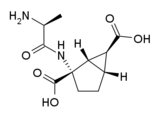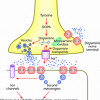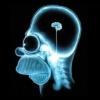From Wikipedia
http://en.wikipedia.org/wiki/Eglumegad
---------------------------------------------------------------------
Eglumegad
Eglumegad (LY354740) is a research drug developed by Eli Lilly and Company, which is being investigated for its potential in the treatment of anxiety[1] and drug addiction.[2] It is a glutamate derived compound and its mode of action implies a novel mechanism.[3]
Mechanism of action
Eglumegad acts as a group-selective agonist for the group II metabotropic glutamate receptors (mGluR2/3).[4][5] It is unclear whether Eglumegad directly interacts with dopamine D2 receptors.[6][7]
Effects
In experiments on mice, eglumegad was found to be as effective as diazepam for treating anxiety symptoms in several standard tests, but without producing any of the negative side effects of diazepam such as sedation and memory impairment.[8] Tests in humans confirmed that it produced anxiolytic effects without producing sedation.[9][10] However it did slightly reduce cognitive performance in tests on monkeys.[11]
Eglumegad has also been found to be effective in relieving the symptoms of withdrawal from chronic use of both nicotine[12] and morphine in animals,[13] as well as inhibiting the development of tolerance to morphine,[14] raising hope that this drug may be useful for treating drug addiction in humans.
Eglumegad and related drugs are neuroprotective[15] and are synergistic with the neuroprotection produced by NMDA antagonist drugs,[16] which may make these drugs useful in aiding recovery from brain injury.
This class of drugs also interacts with hallucinogenic drugs, with eglumegad reducing the effects of 5HT2A agonist hallucinogens,[17] while conversely the mGluR2/3 antagonist LY341495 increased the behavioural effects of these drugs.[18] This suggests that mGluR2/3 agonists such as eglumegad may have potential uses in the treatment of some forms of psychosis, although eglumegad had only limited effects on the action of the dissociative drug phencyclidine[19] which is generally a better model for schizophrenia than the 5HT2A agonist hallucinogens.[20]
Eglumegad also interferes in the hypothalamic–pituitary–adrenal axis, with chronic oral administration of this drug leading to markedly reduced baseline cortisol levels in bonnet macaques (Macaca radiata); acute infusion of eglumedgad resulted in a marked diminution of yohimbine-induced stress response in those animals.[21]
In human adrenocortical cells, Eglumegad has been shown to down-regulate intracellular cyclic AMP (cAMP) and steroidogenesis, with a significant decrease in aldosterone and cortisol production.[22]
Clinical development
Development of this drug is continuing, with several clinical trials completed and more planned.[23] Poor oral bioavailability of the original formulation led to limited efficacy in the initial human trials,[24] and so the prodrug form LY544344 is more likely drug candidate for further development.[25][26][27][28]


LY-544,344
--------------------------------------------------------------
This sounds pretty interesting.. I have been trying to find current glutamatergic racetams and ampakines which have similar pharmacology but it has been difficult to find much... I believe at least one paper mentioned piracetam's use as an antipsychotic and its affinity for MGluR II & III, but it failed to mention any specifics. I will try to dig up the studies again. I would love to find an easily available MGluR 2/3 agonist though!!

















































